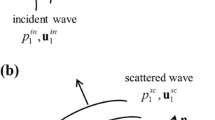Abstract
Materials are often characterized by measuring the velocity and attenuation of ultrasonic waves. Laser-ultrasonics, which uses lasers for generation and detection of ultrasound, has several advantages compared to the classical piezoelectric techniques, but the use of lasers is often associated with ill-defined source and receiver characteristics making diffraction effects hard to evaluate. We have identified two regimes which, in practice, allow the measurement of velocity and attenuation: the point source/point receiver and the large uniform source/large uniform receiver regimes. These approaches are discussed and illustrated with several examples of application. Limitations caused by misalignment between the generating and detecting laser spots are also analyzed.
Similar content being viewed by others
References
E. Schreiber, O. Anderson, and N. Soga,Elastic Constants and Their Measurements, (McGraw Hill, New York, 1973).
E. P. Papadakis, Absolute measurements of ultrasonic attenuation using damped nondestructive testing transducers,J. Testing Eval. 12 273–279 (1984).
D. Daniel, K. Sakata, J. J. Jonas, I. Makarow, and J. F. Bussière, Acoustoelastic Determination of the Fourth Order ODF Coefficients and Application to R-Value Prediction, Material Res. Soc., Symposium Proc., Vol. 142, 1989, pp. 77–82; Y. Li and R. B. Thompson, Ultrasonic Characterization of Texture, Material Res. Soc., Symposium Proc., Vol. 142, 1989, pp. 83–88.
D. R. Allen, W. H. B. Cooper, C. M. Sayers, and M. G. Silk, The use of ultrasonics to measure residual stresses, inResearch Techniques in Nondestructive Testing, R. S. Sharpe, ed. (Academic Press, 1982), Vol. VI, pp. 151–209.
A. Vary, Ultrasonic measurement of material properties, inResearch Techniques in Nondestructive Testing, R. S. Sharpe, ed. (Academic Press, 1980), Vol. IV, pp. 159–204.
C. B. Scruby, R. J. Dewhurst, D. A. Hutchins, and S. B. Palmer, Laser generation of ultrasound in metals, inResearch Techniques in Nondestructive Testing, R. S. Sharpe, ed. (Academic Press, 1982), Vol. V, pp. 281–327.
D. A. Hutchins, Mechanisms of pulsed photoacoustic generation,Can. J. Phys. 641247–1264, 1986.
J. -P. Monchalin, Optical detection of ultrasound,IEEE Trans. Ultrasonics, Ferr. Frequency Control UFFC-33485–499, 1986.
U. Schleichert, K. J. Langenberg, W. Arnold, and S. Fassbender, A quantitative theory of laser-generated ultrasound, inReview of Progress in Quantitative Nondestructive Evaluation, D. O. Thompson and D. E. Chimenti, eds., (Plenum Press, New York, 1989), Vol. 8A, pp. 489–496.
R. J. von Gutfeld, 20 MHz acoustic waves from pulse thermoelastic expansions of constrained surfaces,Appl. Phys. Lett. 30257–259 (1977).
R. J. Conant and K. L. Telschow, Longitudinal wave precursor signal from an optically penetrating thermoelastic laser source, inReview of Progress in Quantitative Nondestructive Evaluation, D. O. Thompson and D. E. Chimenti, eds. (Plenum Press, New York, 1989), Vol. 8A, pp. 497–504.
J.- P. Monchalin, R. Héon, P. Bouchard, and C. Padioleau, Broadband optical detection of ultrasound by optical sideband stripping with a confocal Fabry-Pérot,Appl. Phys. Lett. 551612–1614 (1989).
M. Paul, B. Betz, and W. Arnold, Interferometric detection of ultrasound at rough surfaces using optical phase conjugation,Appl. Phys. Lett. 501569–1571 (1987).
K. Yamada and Y. Fujii, Acoustic response of a circular receiver to a circular source of different radius,J. Acoust. Soc. Am.,401193–1194 (1966).
J.- D. Aussel and J.- P. Monchalin, Precision laser-ultrasonic velocity measurement and elastic constant determination,Ultrasonics 27165–177 (1989).
J.- D. Aussel and J.- P. Monchalin, Measurement of ultrasound attenuation by laser ultrasonics,J. Appl. Phys. 652918–2922 (1989).
F. J. Harris, On the use of windows for harmonic analysis with the discrete Fourier transform,Proc. IEEE 6651–83 (1978).
J.- P. Monchalin, R. Héon, J. F. Bussière, and B. Farahbakhsh, Laser-ultrasonic determination of elastic constants at ambient and elevated temperatures, inNondestructive Characterization of Materials II, J. F. Bussière, J.- P. Monchalin, C. O. Ruud, and R. E. Green, Jr. eds. (Plenum Publishing, 1987), pp. 717–723.
R. J. Dewhurst, C. Edwards, A. D. W. Mckie, and S. B. Palmer, A remote laser system for ultrasonic velocity measurement at high temperatures,J. Appl. Phys. 631225–1227 (1988).
L. F. Bresse, D. A. Hutchins, and K. Lundgren, Elastic constants determination using ultrasonic generation by pulsed lasers,Review of Progress in Quantitative Nondestructive Evaluation, in D. O. Thompson and D. E. Chimenti, eds. (Plenum Press, N.Y., 1988), Vol. 7B, pp. 1219–1226.
B. Pouet and N. J. P. Rasolofosaon, Ultrasonic intrinsic attenuation measurement using laser techniques, IEEE Ultrasonic Symposium Proceedings, 1989, pp. 545–549.
Author information
Authors and Affiliations
Rights and permissions
About this article
Cite this article
Monchalin, J.P., Aussel, J.D. Ultrasonic velocity and attenuation determination by laser-ultrasonics. J Nondestruct Eval 9, 211–221 (1990). https://doi.org/10.1007/BF00565639
Received:
Revised:
Issue Date:
DOI: https://doi.org/10.1007/BF00565639




